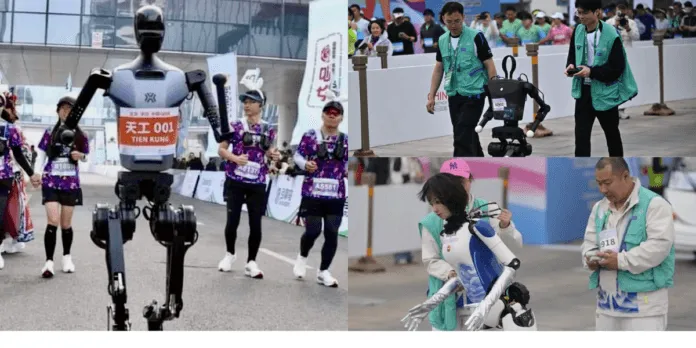China humanoid robot race, where robots taking on humans is an oppressive idea of android athletic supremacy , but for now, at least, there is no need to be afraid. On Saturday, more than 20 two-legged robots competed in the world’s 1st humanoid half marathon in China. However, they were technologically impressive but failed to win over their human masters over the long distance.
Teams from several universities and companies participated in the race as a showcase of advanced humanoid technology in China. They come in a variety of shapes and sizes, jogging through Beijing’s southeastern Yizhuang district, which is home to many of the capital’s tech companies.
Over the past few months, videos of a Chinese humanoid robot performing bike rides, side flips, and roundhouse kicks have broken the internet , often portrayed by country media as a key to economic growth. In the policy of 2023, the Ministry of Industry and Information Technology of China identified human robotics as a “new frontier” in the technological industry, setting a target for mass production by 2025 and a secure supply chain.
Fears have surrounded humans in recent years about how artificial intelligence (AI) may outsmart us while AI models are gaining a fast reputation, causing concerns about everyone’s security to work in the future. Saturday’s race recommends that humans still at least have supremacy when it comes to running. The robots competed against 12,000 human participants, running side by side with them in fenced-off lanes.
After setting off from the park of the country, competing robots had to overcome light slopes and a winding 13-mile (21-kilometer) circuit before they could finish the race. Just as human runners needed to freshen themselves up with water, robots were also allowed to get new batteries during the race. Companies were also allowed to transfer their androids with substitutes when they could no longer compete, with a 10-minute penalty.
The first robot to cross finish lines was Tiangong Ultra, who finished the route in two hours and 40 minutes. It was created by the Beijing Humanoid Robot Innovation Center. The robot’s finishing time is nearly 2 hours short of the human world record of 56 minutes and 42 seconds. The man, the winner of the race, crossed the winning line in one hour and 2 minutes.
The professor of computer science, AI, and robotics at Oregon State University, Alan Fern, said that he was actually impressed that robots finished the race within the time limit. Even though he would bet that none of them could finish. He also added that there are many companies that are developing their own humanoid robots across the world, like in China, the US, and Europe, but there is no ‘clear leader’ at this point.
Chief technology officer for the robotics innovation center, Tang Jian, said that Tiangong Ultra won the race because of long legs and an algorithm allowing him to mimic how humans run a marathon. “ I don’t want to boast, but I think no other robotics firms in the West have matched Tiangong’s sporting achievements”, Tang commented.
According to the Reuters news agency, the robots needed to switch batteries only three times. The 1.8-meter robot had to face a few challenges during the race, which included multiple battery changes. It also needed another hand to run alongside it with his hand holding his back to prevent a fall. Moreover, ,most of robots also needed this kind of supports , with few tied with a chain and some were remote controlled
The competing human had no difficulty keeping up the race, running in the other side lane. Some curious participants also take out their phones to capture the moments as they are running along.


